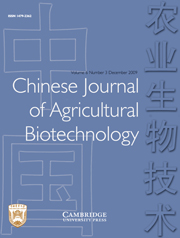Crossref Citations
This article has been cited by the following publications. This list is generated based on data provided by
Crossref.
Ahmad, Iqbal
Khan, Mohd Sajjad Ahmad
Husain, Fohad Mabood
Zahin, Maryam
and
Singh, Mahipal
2011.
Microbes and Microbial Technology.
p.
127.
Fan, Jiaqin
Qian, Guoliang
Chen, Tao
Zhao, Yuqiang
Liu, Fengquan
Walcott, Ron R.
and
Hu, Baishi
2011.
The acyl-homoserine lactone (AHL)-type quorum sensing system affects growth rate, swimming motility and virulence in Acidovorax avenae subsp. citrulli.
World Journal of Microbiology and Biotechnology,
Vol. 27,
Issue. 5,
p.
1155.
BURDMAN, SAUL
and
WALCOTT, RON
2012.
Acidovorax citrulli: generating basic and applied knowledge to tackle a global threat to the cucurbit industry.
Molecular Plant Pathology,
Vol. 13,
Issue. 8,
p.
805.
Johnson, Kameka Latoya
and
Walcott, Ronald Ricardo
2013.
Quorum Sensing Contributes to Seed‐to‐Seedling Transmission of Acidovorax citrulli on Watermelon.
Journal of Phytopathology,
Vol. 161,
Issue. 7-8,
p.
562.
Wang, Tielin
Guan, Wei
Huang, Qi
Yang, Yuwen
Yan, Wanrong
Sun, Baixin
and
Zhao, Tingchang
2016.
Quorum-sensing contributes to virulence, twitching motility, seed attachment and biofilm formation in the wild type strain Aac-5 of Acidovorax citrulli.
Microbial Pathogenesis,
Vol. 100,
Issue. ,
p.
133.
Rahimi-Midani, Aryan
Lee, Yong Seok
Kang, Se-Won
Kim, Mi-Kyeong
and
Choi, Tae-Jin
2018.
First Isolation and Molecular Characterization of Bacteriophages Infecting Acidovorax citrulli, the Causal Agent of Bacterial Fruit Blotch.
The Plant Pathology Journal,
Vol. 34,
Issue. 1,
p.
59.
Zaheriani, Davood
Hosseinzadeh, Saeed
Mahmoodi, Esmail
and
Shams-bakhsh, Masoud
2019.
The effect of the N-acyl-homoserine lactonase on the properties of Pectobacterium betavasculorum.
Journal of Plant Pathology,
Vol. 101,
Issue. 1,
p.
81.
Guan, Wei
Wang, Tielin
Huang, Qi
Tian, Eryuan
Liu, Bo
Yang, Yuwen
and
Zhao, Tingchang
2020.
A LuxR‐type regulator, AcrR, regulates flagellar assembly and contributes to virulence, motility, biofilm formation, and growth ability of Acidovorax citrulli.
Molecular Plant Pathology,
Vol. 21,
Issue. 4,
p.
489.
Guan, Wei
Wang, Tielin
Huang, Qi
Zhao, Mei
Tian, Eryuan
Liu, Yanfeng
Liu, Bo
Yang, Yuwen
and
Zhao, Tingchang
2021.
Transcriptomic and Functional Analyses Reveal Roles of AclR, a luxR-type Global Regular, in Regulating Motility and Virulence of Acidovorax citrulli.
Molecular Plant-Microbe Interactions®,
Vol. 34,
Issue. 8,
p.
952.
2021.
Full Issue PDF.
Molecular Plant-Microbe Interactions®,
Vol. 34,
Issue. 8,
p.
880.
Ruan, Qi
Geng, Shuting
Yu, Jianqiu
Lu, Leilei
Liu, Yanhua
Chen, Jianqiu
Liao, Qianjiahua
and
Guo, Ruixin
2026.
Microbial quorum sensing: Mechanisms, applications, and challenges.
Biotechnology Advances,
Vol. 86,
Issue. ,
p.
108733.

